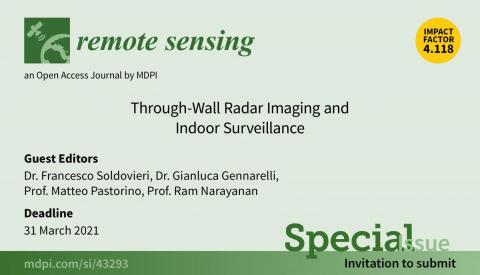Special Issue on "Through-Wall Radar Imaging and Indoor Surveillance"

We are organizing the Special Issue "Through-Wall Radar Imaging and Indoor Surveillance" on Remote Sensing!
DEADLINE EXTENDED - November 30, 2021
You are invited to submit a paper!
Special Issue Information
Through-wall radars are attracting notable interest for the identification of targets in complex and closed or inaccessible building environments, thanks to the capability of electromagnetic signals to penetrate opaque media in frequencies ranging from some hundreds of megahertz to a few gigahertz. As a result, these systems have profound implications in military and public security fields, such as search and rescue missions, law enforcement, indoor surveillance, and building interior reconstruction, to name but a few examples.
In the last decade, notable technological advances have led to the development of advanced radar systems based on different waveforms (pulsed, stepped-frequency, frequency-modulated continuous wave, noise, etc.) and operating under different (physical/synthetic) antenna array configurations (monostatic, bistatic, MIMO). Aside from active radar transceivers, passive through-wall radars exploiting ubiquitous devices as opportunistic illuminators (e.g., Wi-Fi access points) have also been developed.
Through-wall radar technology has now matured, but some technical issues demand signal-processing approaches capable of providing quick and reliable information at the scene under investigation. For example, the ringing effect caused by multiple reflections inside the front wall is a strong source of clutter to be filtered while imaging stationary targets. Aside from clutter rejection methods, SAR imaging algorithms play a crucial role in providing, to the end-user, a clear and focused image of the surveillance area which is more easily interpretable than raw data. In this respect, accurate modeling of the electromagnetic sensing process that also accounts for multipath radar signal propagation in the complex indoor environment can be exploited improve the imaging performance. Signal processing strategies can be also devised to mitigate the effect of artifacts produced by the mutual interactions between nearby targets.
The image formation process is preliminary to higher-level signal processing procedures such as automatic detection and tracking capable of estimating the real-time position and dynamics of targets in the scene. Similarly, classification algorithms play a relevant role for human activity recognition as well as building feature extraction.
This Special Issue aims at highlighting the most recent scientific and technological advances in the field of through-wall radar imaging and indoor surveillance with a focus on hardware, modeling, and data processing. We solicit the submission of original research articles as well as review articles that explore the following non-exhaustive list of topics.
- Active/passive through-wall radar systems for real-time sensing and imaging
- Forward and inverse electromagnetic scattering models
- Clutter rejection and multipath exploitation data processing approaches
- SAR focusing algorithms for UWB radar
- Compressive sensing for through-wall radar imaging
- Building layout imaging and feature extraction
- Data processing approaches exploiting opportunistic sources for real-time surveillance
- Moving human target detection and tracking in indoor environments
- Statistical methods and artificial intelligence tools for radar image classification
- Vital body and human activity signal detection and monitoring
Integration of radar systems in surveillance systems exploiting other kinds of sensors (optical camera, infrared cameras, lidar, magnetometers, optic fiber sensors, etc.)
Dr. Francesco Soldovieri
Dr. Gianluca Gennarelli
Prof. Matteo Pastorino
Prof. Ram Narayanan
Guest Editors
